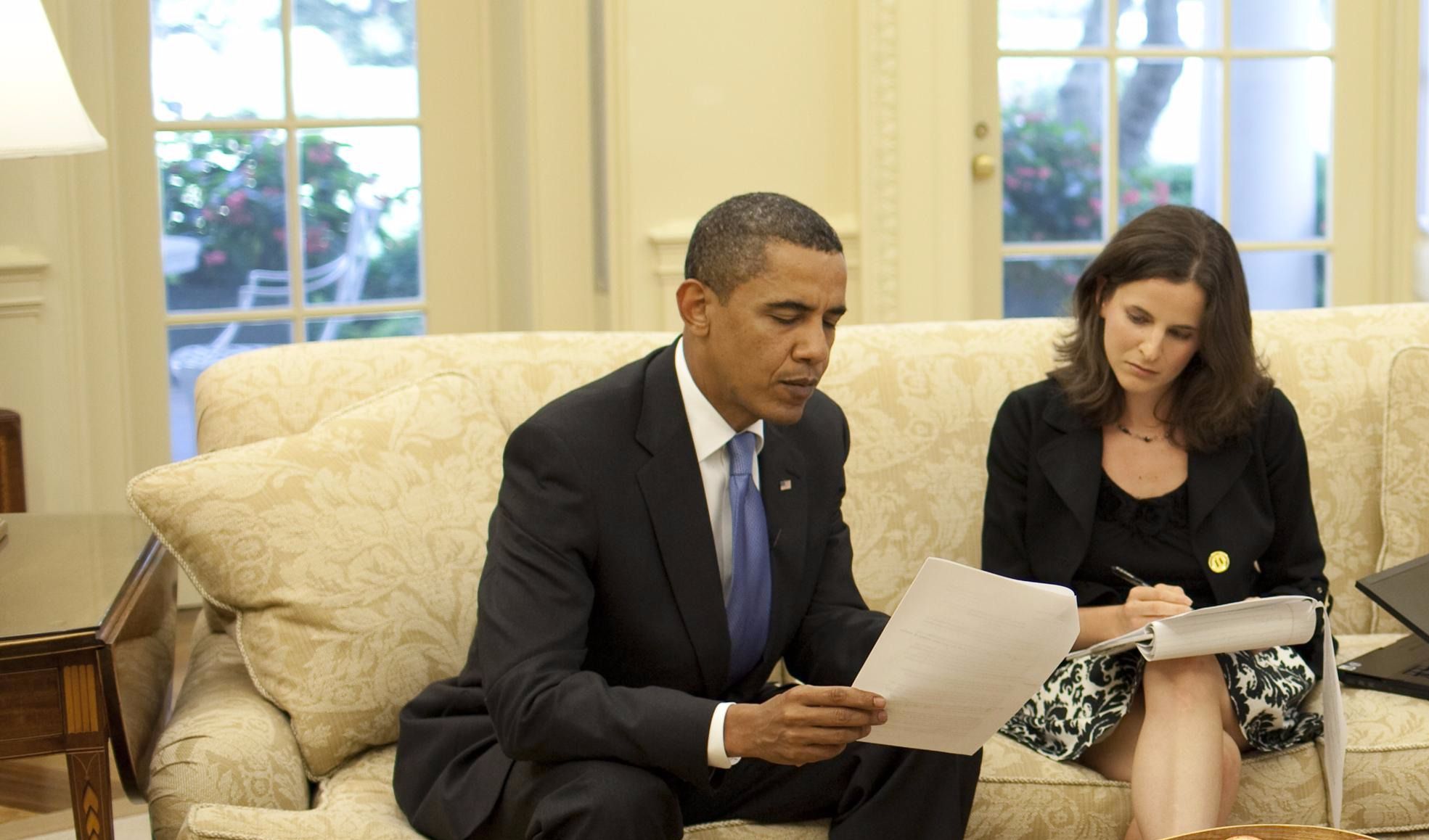Fashion
How to Write a Great Speech, According to Obama’s Speechwriter
Sarah Hurwitz served as head and senior speechwriter to first lady Michelle Obama and President Barack Obama. Here, she shares 11 tips to master the art form of speechwriting….



It was the summer of 1998, the end of her junior year of college, when Sarah Hurwitz fell in love with the art form of writing the perfect speech, having scored an internship at the White House in Vice President Al Gore’s speechwriting office. “Every day, his staff used words to move, inspire, comfort, and empower people,” she recalls. “I still can’t imagine a better way to spend a career.”
And what an extraordinary career Hurwitz’s has been. After graduating from Harvard Law School, she became the chief speechwriter for Hillary Rodham Clinton on her 2008 presidential campaign. Eventually, she returned to the White House, serving as the head speechwriter for first lady Michelle Obama and as a senior speechwriter for President Barack Obama between 2009 and 2017.
Here, Hurwitz shares 11 nuggets of speechwriting wisdom that she’s garnered along the way so that you can shine at your next public address, whether that be a televised political debate, a work presentation, or a toast at your best friend’s wedding.
1. Channel the person who is speaking
The true art of speechwriting isn’t scripting someone—it’s channeling their voice. My first step when writing a speech for Mrs. Obama would be to sit down with her and ask, “What would you like to say?” She knows who she is, and she always knows what she wants to say. She’s also a naturally gifted speaker and writer, so I’d transcribe as she talked, forming the basis of the first draft.
2. Research and understand your audience
Who are you talking to? What are they concerned about? Why are you speaking to them? How well do they know you? What’s the venue? If Mrs. Obama was speaking at a university, for example, it was important to understand the history and student body of that university. If you’re giving a toast at your best friend’s wedding, you need to know if you can tell a story that’s a bit edgy or if their family will get offended.
3. Know that structure is destiny
If you have a bad structure, you can’t have a good speech. Every paragraph should flow logically from one to the next. When I’m trying to figure out the structure of a speech, I’ll often print it out and cut it up with scissors so I can move parts around. It’s only then that I realize the order is wrong or I see that I’m repeating myself or I notice that certain passages could be combined.
4. Seek multiple opinions
It’s really important to ask other people to look at your speech—as many as possible, especially if you’re speaking to a community that you don’t know well. You need to find someone from that audience who understands its cultural sensitivities and norms so you speak in a way that inspires people rather than causing offense.
5. Throw the rulebook out of the window
Writing to be read and writing to be heard are two very different skills. Spoken language doesn’t need to conform to grammar and punctuation norms. I often use ellipses instead of commas to indicate pauses because they’re easier to see. It’s fine to space things weirdly on the page or add notations if it helps you—all that matters is how the words sound coming out of your mouth.
With that in mind, you should edit out loud. Don’t just sit looking at your computer screen—print the speech out, practice delivering it, and edit as you go.
Fashion
Raekwon Unveils “The Emperor’s New Clothes” With All-Star Lineup

Raekwon, a legendary rapper known for his role in the Wu-Tang Clan, has just announced his long-awaited eighth studio album, titled “The Emperor’s New Clothes,” set to be released through Mass Appeal. Although no singles have been shared yet, the album is already creating a buzz and is highly anticipated this summer. It’s been seven years since Raekwon last released a solo album, and this new project feels more like a grand return than just another release.
He’s teamed up with a mix of familiar faces from the Wu-Tang Clan and some fresh talent in hip-hop. Listeners can look forward to clever lyrics and captivating stories filled with raw emotion. Raekwon has invited his Wu-Tang brothers Ghostface Killah, Method Man, and Inspectah Deck to feature on the album, ensuring a classic blend that fans love. He’s also brought in well-respected artists outside of the Wu-Tang family, like Nas and members of the Griselda collective, Westside Gunn, Benny The Butcher, and Conway The Machine, who are known for their gritty style.
Adding to the variety, singers Stacy Barthe and Marsha Ambrosius will provide soulful vocals to complement Raekwon’s hard-hitting verses. The album’s production features talented names like Swizz Beatz, Nottz, J.U.S.T.I.C.E League, Frank G, and Roadsart, promising a rich, cinematic sound that matches Raekwon’s lyrical skills. Even with such an impressive lineup, there’s still a sense of mystery around the album. There have been no early songs or previews released, just the announcement itself, which builds even more expectation.
But for Raekwon, this is part of his journey. He has always delivered powerful lyrics and relatable street stories without much introduction. The title, The Emperor’s New Clothes, suggests a fresh start and a daring vision that might challenge the current state of rap. With his experienced flow and storytelling still sharp, Raekwon seems prepared to reestablish his place among the top artists in hip-hop.
Fashion
Wendy Williams Makes Stylish Splash At Columbia Supporting Her Designer

In a delightful surprise for fans and fashion enthusiasts, Wendy Williams made a rare appearance at Columbia University on Tuesday, and everyone couldn’t help but notice her. The former talk show host was in high spirits as she showed up to support her longtime friend and fashion designer, Mel Maxi. Wendy looked fantastic in a stylish black-and-white outfit that included a Yankee hat and her trademark flair.
Designed by Maxi himself, her outfit was not just chic but also had a personal touch that highlighted her vibrant personality. In a heartwarming moment recorded on video, Wendy told Maxi, “This is amazing! This was specifically designed for me… this is really hand done.” Wendy came to cheer on Maxi, who was set to give a lecture about fashion design at the prestigious university. Her appearance was a meaningful moment between two creative friends who have supported each other for years. Wendy’s presence emphasized the importance of friendship and collaboration in the creative world.
As she walked by, a nearby fan shouted their love for Wendy, and she instinctively responded with her signature warmth and enthusiasm: “Thank you!” she exclaimed with a big smile. After being away from the spotlight for months, Wendy’s visit was a refreshing change for fans who have missed her lively spirit. There were no fancy events or flashing cameras, just Wendy enjoying the moment, supporting a friend, and reminding us all of the significance of showing up for the people we care about.
-

 Artist Spotlight10 hours ago
Artist Spotlight10 hours agoHaydeezy sets the season in motion with the effortless summer anthem “Bounce”
-

 Artist Spotlight8 hours ago
Artist Spotlight8 hours agoCircleKSK ignites an anime-metal collision on “UnBreakable Turn” ft. Anya J
-

 Artist Spotlight9 hours ago
Artist Spotlight9 hours agoRecc explores nostalgia and inner freedom in “Where the Wild thYngs Are”
-

 Artist Spotlight9 hours ago
Artist Spotlight9 hours agoCharley Young reclaims her voice with the raw and revelatory single “A Song About You”
-

 Artist Spotlight9 hours ago
Artist Spotlight9 hours agoAnnaBelle Swift delivers gentle hope and gratitude with new single “Heaven Sent”
-

 Artist Spotlight9 hours ago
Artist Spotlight9 hours agoGarth Adam keeps the flame of Journeysong burning with the new single “Three Fires”
-

 Artist Spotlight10 hours ago
Artist Spotlight10 hours agoSandra Mae Lux rekindles timeless holiday magic with “This December Love”
-

 Artist Spotlight9 hours ago
Artist Spotlight9 hours agoChris Pannella honors a classic with his stripped-down take on “The Rain Song”

